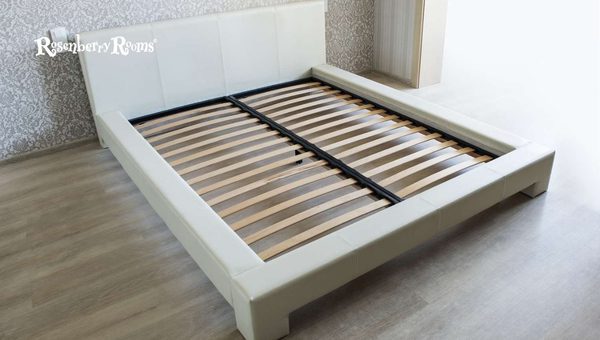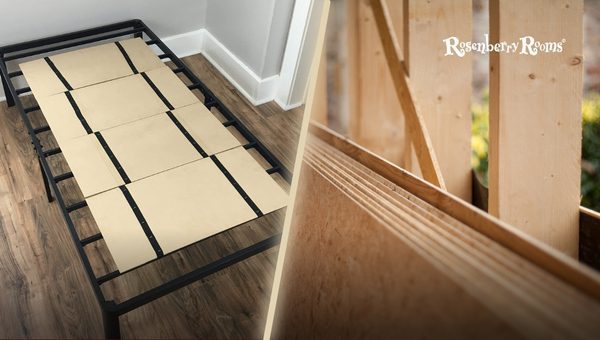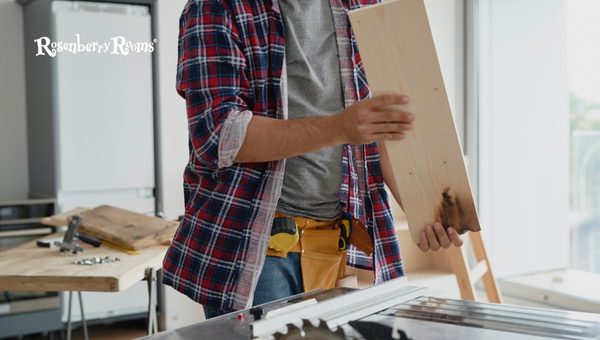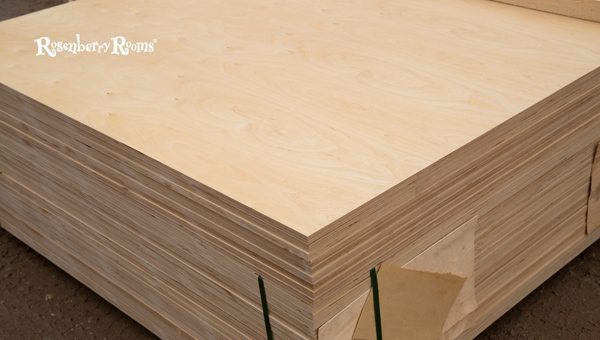You may be considering a DIY approach to revamp your bed support system, wondering, "Can I use plywood instead of a bunkie board?" This is a valuable question to ponder, especially when looking for cost-effective solutions and planning to manage them with keen practicality.
Buckle up as we guide you through this article to distill the complexities of this topic. Understanding the uses, differences, pros, and cons of using plywood as a substitute for bunkie boards is crucial for your comfort and sleep quality.
Whether you're planning to refurbish your bed or even an old one lying in your guest room, our decision-making process often boils down to affordability, longevity, and the aptness of the materials. Buckle up as we dive deeper into these aspects so that you can make an informed decision.
Contents
A Bunkie Board is a flat piece of material, typically made of particleboard or plywood, designed to fit between a mattress and its bed frame.
Its primary function is to provide solid support for the mattress and increase its lifespan by evenly distributing weight and pressure. It benefits platform beds and bed frames that lack sufficient support slats.
Bunkie Boards usually measure between one to three inches thick, helping to maintain the low-profile look of your bed setup while offering robust stability and comfort.

A Bunkie Board is typically made of sturdy, flat material such as plywood or particle board and may be covered with upholstery fabric for added appeal and protection. Some high-end Bunkie Boards are also made of solid wood or metal.
The way a Bunkie Board works is fairly straightforward. It is placed directly between your mattress and the bed frame - whether a platform bed, box spring, daybed, or trundle bed - to provide a solid foundation.
This additional layer offers enhanced support by distributing the weight of the mattress and the sleepers evenly across the frame, thereby preventing sagging or wear over time.
Despite being thin in structure, Bunkie Boards are built to withstand substantial weight loads without losing form, thus helping prolong the life expectancy of your mattress.
Also Read About How To Decoupage On Wood Furniture [A Step-by-Step Guide]
Yes, you can use a piece of plywood instead of a Bunkie Board. The key is to cut the plywood to match the exact dimensions of your bed frame for a snug fit. The thickness should be at least 3/4 inch for proper support.
It's also essential to sand down any rough edges to prevent damage to your mattress, and you might want to wrap the plywood in a fabric cover for added protection.
Keep in mind that while this DIY solution may save money, commercial Bunkie Boards are designed explicitly with optimal support and durability in mind. Always weigh your options based on your specific needs and budget.

Knowing the differences between a Bunkie Board and plywood is crucial before deciding which one suits your needs.
While both provide solid support for your mattress, there are certain elements to consider, such as durability, price, ease of use, and preparation.
Choosing to use a Bunkie Board has advantages and disadvantages, and understanding each can help you make the best decision for your specific requirements.

Crafting a DIY plywood substitute for your bunkie board can be an exciting weekend project. It's also a cost-effective method that may give your bedding structure a personalized touch.
Precision, patience, and attention to simple details ensure the plywood works efficiently as a makeshift bunkie board.
Before diving straight into the crafting process, knowing what you're signing up for is reasonable. Using plywood as a makeshift bunkie board involves measuring your bed frame accurately, purchasing and cutting the plywood according to these measurements, then sanding and sealing the wood for durability and protection against moisture.
The first step to creating a DIY bunkie board is accurately measuring your bed frame's dimensions. Use a measuring tape to get the precise length and width of the frame where the mattress sits.
This measurement will determine the size of plywood that you need to purchase from your local hardware store. The plywood should fit perfectly within the frame to provide maximum support and stability for your mattress.
The next step is purchasing a plywood sheet that matches or exceeds your measured dimensions. Opt for a plywood thickness of at least 3/4 inch to ensure optimal support.
Plywood sheets can be found at any local hardware store; buy one equal to or larger than your measurements.
If more significant, it must be cut down to the perfect size, which most hardware stores can do for you immediately. Always recheck your measurements before laying down the cash for the plywood.
Once you have your plywood sheet, the next step is to mark the required measurements on it. Using a pencil, ruler, or straight edge, carefully draw the dimensions you measured on your bed frame onto the plywood sheet.
Ensure your lines are straight, as these will act as your guide for cutting the plywood. Double-check your markings before cutting - your DIY bunkie board must fit neatly into your bed frame for optimal support and stability.
Now that your measurements are marked out, it's time to cut the plywood sheet down to size. Applying a circular saw or table saw, carefully follow the lines you've drawn on the plywood. Ensure your cuts are clean and straight.
If you're not comfortable handling power tools, you could seek assistance from a friend who is or have it cut at your local hardware store instead. It's crucial to use essential safety equipment like eye protection and gloves while performing this step.
After making the required cuts, you'll likely notice rough spots or splinters along the edges. Your next step is to smooth out these imperfections using sandpaper.
Sand along the edges and corners of your cut plywood until all the rough spots are gone, and you're left with smooth surfaces.
This eliminates potential splinters and prevents damage to your mattress from rugged edges. Remember to work in a well-ventilated area during this process, as sanding can generate considerable dust particles.
Once the plywood is cut down to size and nicely sanded, ensure it's well-protected for long-term use. Use a sealant or paint suitable for plywood and apply it all over the board, focusing more on the edges to prevent moisture absorption and particle flaking. Ensure that the sealant or paint you choose is safe and compatible with plywood.
The protective layer adds to the visual appeal while acting as a buffer against potential moisture damage, enhancing your DIY bunkie board's lifetime. Ensure adequate drying time before using it on your bed, as the sealant or paint instructions advise.
Adding a non-slip pad or fabric to one side of your plywood will prevent your new DIY bunkie board from sliding around on the bed frame. You can purchase a non-slip pad from most home goods stores. Cut it to the exact measurements as your plywood and secure it using strong adhesive or staples.
Remember not to let any staples protrude, as they might tear into your mattress. With this in place, you’re all set with your homemade bunkie board ready to provide robust support for your mattress while ensuring a sturdy and creak-free sleeping surface.
Position the plywood on your bed frame with the non-slip side facing downward. Ensure it fits snugly within the frame and doesn't move or slide around when applying pressure. This will protect your mattress and ensure a stable and comfortable sleeping surface that supports your bed effectively, preserving its lifespan.
After placing the plywood on the bed frame, please take a moment to ensure that it fits snugly within its boundaries.
The plywood should ideally cover the entire surface area of your bed frame for even weight distribution and maximum support. Its edges should align perfectly with your bed frame without overhangs or gaps.
A well-fitted DIY bunkie board, created from plywood, will not only withstand a considerable amount of weight but also prevent the sagging of the mattress, adding to both durability and comfort levels for an improved sleep experience.
Once you've verified that your DIY bunkie board fits properly, the final step is to place your mattress on top of the plywood.
The bunkie board will act as a supportive barrier between your bed frame and mattress, helping to distribute weight evenly and prevent any chance of sagging. This extends the life of your mattress and enhances overall comfort, promising restful sleep night after night.
Now pat yourself on the back for successfully creating a functional bedding accessory that meets your personal needs and budget.
Explore More: 30 Best Paint Colors That Go With Dark Wood [ Latest]
Yes, purchasing a sheet of plywood tends to be less expensive than buying a commercially made bunkie board. While the exact cost difference will depend on the specific prices in your locality and the size and quality of the materials, DIY solutions using plywood usually offer a more economical alternative.
Bear in mind that while you might save on upfront costs, a makeshift plywood solution may not provide the same durability and specialized support as a purpose-built bunkie board. Always consider both cost-effectiveness and functionality when making your choice.

Whether you need a bunkie board or not depends on your bed setup and mattress. Generally, bunkie boards are essential for platform beds and bed setups with sparse slat support because they provide a flat, solid surface that prevents mattress sagging and extends lifespan.
They're beneficial under foam-based mattresses or any mattress requiring a flat foundation versus individual slats. Bunkie Boards are also an excellent choice if you desire a lower bed height, as they provide robust support without adding much height to the bed setup.
If your bed frame already has sufficient built-in support (like closely set slats or a solid platform), it's possible you may not need a bunkie board. Always check with your mattress manufacturer for the best foundation for your specific mattress type and sleeping needs.
Read More: How To Mix and Match Bedroom Furniture Like a Pro
Plywood can be a viable substitute due to its durability, availability, and ease of customization to fit bed frames.
No, if the plywood is at least 3/4 inch thick and properly fits within your bed frame, it will not impact your mattress's comfort.
Yes, providing you have sanded down any rough edges and covered the plywood with fabric or a protective sealant.
Likely, buying a sheet of plywood often costs less than purchasing a commercially produced bunkie board.
While both provide solid support for mattresses, remember that manufactured bunkie boards might offer superior quality and durability for heavyweight beds.
You can utilize plywood as a stand-in for a bunkie board. This clever DIY method can support your mattress, increase its longevity, and often do the job more cost-effectively. At the same time, this approach may tick all of your boxes regarding practicality and cost.
It's also essential to weigh the benefits of manufactured bunkie boards in terms of precise design, enhanced durability, and overall quality. Always ensure whichever route you take aligns with your comfort and sleep health priorities.